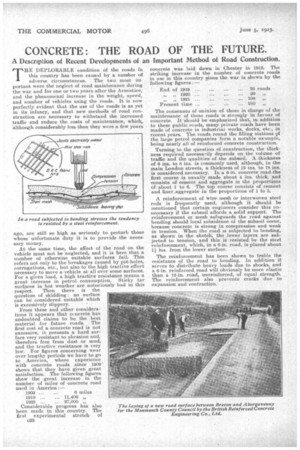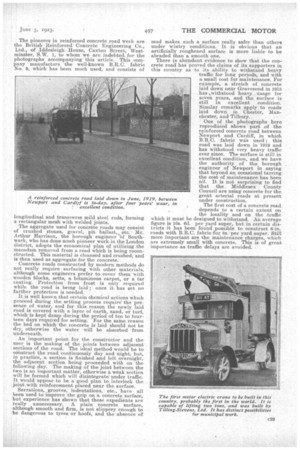CONCRETE: THE ROAD OF THE FUTURE.
Page 12

Page 13

If you've noticed an error in this article please click here to report it so we can fix it.
A Description of Recent Developments of an Important Method of Road Construction.
THE DEPLORABLE condition of the roads in this country has been caused by a number of adverse circumstances. The two most be portant were the neglect of road maintenance during the war and for one or two years after the Armistice, and the phenomenal increase in the weight, speed, and number of vehicles using the roads. It is now perfectly evident that the use of the roads is as yet in its infancy, and that new methods of road construction are necessary to withstand the increased traffic and reduce the costs of maintenance, which, 'although considerably less than they were a few years
ago, are still so high as seriously to perturb those whose unfortunate duty it is to provide the necessary money.
At the Same time, the effect of the road on the vehicle must not be neglected, and it is here that a number of otherwise suitable surfaces fail. This refers not only to the breakages caused by pot-holes, corrugations, etc., but also to the high tractive effort necessary to move a vehicle at all over some surfaces. For a given load, a high tractive resistance means a great increase in petrol consumption. Sticky tar is excessively slippery. • • From these and other considersLion it. appears that cfnerete has undoubted claims to be the best material for future roads. The first cost of a. concrete road is not excessive, it presents a hard surface very resistant to abrasion and, therefore free from dust or mud,.
and the tractive resista,nee is very lowFor figures concerning wear over lengthy 'periods we have to go
to America, where experience with conemte roads since 1909
shows that they have given great satisfaction. The following figures show the great increase in the number of miles of concrete road used in America :—
1909 ... 6 miles 1919 ... ... 11,400 „ 1923 ... 27,000 ,;
Considerable progress has also been made in this country. The first experimental stretch of 028 concrete was laid down in Chester in 1912. The striking increase in the number of concrete roads in use in this country since the war is shown by the following figures :— The consensus of (minion of those in charge of the maintenance of these roads is strongly in favour of concrete. It 'should be emphasized that, in addition to these public roads, many private roads have been made of concrete in industria,i works, docks, etc., in recent years. The roads round the filling stations of the large petrol companies form a notable example, being nearly all of reinforced concrete construction.
Turning to -the question of construction, the thickness required necessarily depends on the volume -of traffic and the qualities of the subsoil. A thickness of 6 ins, to S ins, is commonly used, although, in the main London streets, a thickness of 15 ins. to 18 ins. is considered necessary. In a 6-in. concrete road-the first course is usually 'made about 4 ins, thick, and consists of cement and aggregate in the proportions of about 1 to 6. :The top course consists of cement and finer ,aggregate in the proportions of 1 to 3.
A reinforcement of wire mesh or interwoven steel rods is frequently used, although it should be mentioned that certain engineers consider this unnecessary if the subsoil affords a solid support. The reinforcement or mesh safeguards the road against bending should local subsidence of the subsoil occur, because concrete is strong in compression and weak in tension. When the road is subjected to 'bending, as shown in the sketch, the lower layers are subjected, to tension, and this is resisted by the steel reinforcement, which, in a 6-in, road, is placed about II ins, from the lower surface.
The reinforcement has been shown to treble the resistance of the road to bending. In addition it serves to distribute heavy loads due to shocks, and a 6-in, reinforced road will obviously be More elastic than a 12-in, road, unreinforced, of equal strength. The reinforcement also prevents cracks due to expansion and contraction.
The pioneers in reinforced concrete road wo/k are the British Reinforced Concrete Engineering Co., Ltd., of Iddesleigh House, Caxton Street, Westminster, S.W. 1, to whom we are indebted for the photographs accompanying this article. This company manufacture the well-known B.R.C. fabric No. 9, which has been much used, and consists of longitudinal and transverse mild steel rods, forming a rectangular mesh with welded joints.
The aggregate used for concrete roads may consist of crushed stones, gravel, pit ballast, etc. Mr. Arthur Harrison, the borough engineer of Southwark, who has done much pioneer work in the London district, adopts the economical plan of utilizing the macadam removed from a road which is being reconstructed. This material is cleansed and crushed, and is then used as aggregate for the concrete. Concrete roads constructed by modern methods do not really require surfacing with other materials, although some engineers prefer to cover them with wooden blocks, setts, a bituminous carpet, or a tar coating. Protection from frost is only required while the road is being laid ; once it, has set no further protection is needed.
It is well known that certain chemical actions which proceed during the setting process require the presence of water' and for this reason the newly laid road is covered with a layer of earth, sand, or turf, which is kept damp during the period of ten to fourteen days required for setting. For the same reason the bed on which the concrete is laid should not be dry, otherwise the water will be absorbed from underneath.
An important point for the constructor and the user is the making of the joints between adjacent sections of the road. The ideal method would be to construct the road continuously day and night, but, in practice, a section is finished and left overnight, the adjacent section being proceeded with on the following day. The making of the joint between the two is an important matter, otherwise a weak section will be formed which will disintegrate under traffic. It would appear to be a good plan to interlock the joint.with reinforcement placed near the surface.
Serrations, grooves, indentations, etc., have all been used to improve the grip on a concrete surface, but experience has shown that these expedients are really unnecessary. A plain concrete surface although smooth and firm, is not slippery enough tO be dangerous to tyres or hoofs, and the absence of mud makes such a surface really safer than others under wintry conditions. It is obvious that an artificially roughened surface is more liable to be abraded than a smooth one.
There is abundant evidence to show that the con
crete rod(' has proved the claims of its supporters in this country as to its ability to withstand heavy traffic for long periods, and with a small cost for maintenance. For example, a stretch of concrete laid down near Gravesend in 1915 has &withstood heavy usage for seven years, and the surface is still in excellent condition. Similar remarks apply to roads laid down in Chester, Manchester, and Tilbury.
' One of the photographs here reproduced shows part of the reinforced concrete road between Newport and Cardiff, in which B.R.C. fabric was used ; this road was laid down in 1919 and has withstood very heavy traffic ever since. The surface is still in excellent condition, and we have the authority of the borough engineer of Newport in saying that beyond an occasional tarring the cost of maintenance has been nil. It is not surprising to find that the _ Middlesex County Council are using concrete for the great arterial roads at present under construction.
The first cost of a concrete road depends to a certain extent on the locality and on the traffic which it must be designed to withstand. An average figure is 10s. 6d. per yard super, but in certain districts it has been found possible to construct 6-in. roads with B.R.C. fabric for 8s. per yard super. Still more important are the maintenance charges which are extremely small with concrete. This is of great importance as traffic delays are avoided.








































